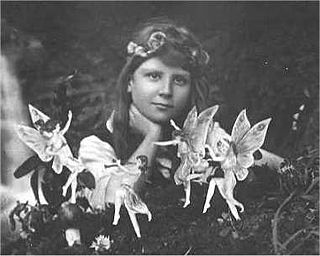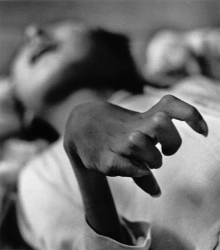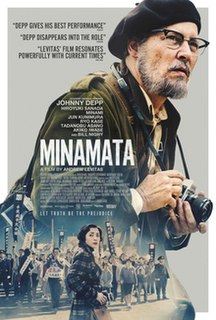
The Cottingley Fairies appear in a series of five photographs taken by Elsie Wright (1901–1988) and Frances Griffiths (1907–1986), two young cousins who lived in Cottingley, near Bradford in England. In 1917, when the first two photographs were taken, Elsie was 16 years old and Frances was 9. The pictures came to the attention of writer Sir Arthur Conan Doyle, who used them to illustrate an article on fairies he had been commissioned to write for the Christmas 1920 edition of The Strand Magazine. Doyle, as a spiritualist, was enthusiastic about the photographs, and interpreted them as clear and visible evidence of psychic phenomena. Public reaction was mixed; some accepted the images as genuine, others believed that they had been faked.

Anna Nicole Smith was an American model, actress, and television personality. Smith first gained popularity in Playboy magazine when she won the title of 1993 Playmate of the Year. She modeled for fashion companies, including Guess, H&M, Heatherette and Lane Bryant.

Aileen Carol "Lee" Wuornos was an American serial killer and sex worker who murdered seven men in Florida in 1989 and 1990 by shooting them at point-blank range. Wuornos claimed that her victims had either raped or attempted to rape her while they were soliciting sex from her, and that all of the homicides were committed in self-defense. She was sentenced to death for six of the murders and was executed by lethal injection on October 9, 2002.

Minamata disease, sometimes referred to as Chisso-Minamata disease, is a neurological disease caused by severe mercury poisoning. Signs and symptoms include ataxia, numbness in the hands and feet, general muscle weakness, loss of peripheral vision, and damage to hearing and speech. In extreme cases, insanity, paralysis, coma, and death follow within weeks of the onset of symptoms. A congenital form of the disease can also affect fetuses in the womb.

Minamata is a city located in Kumamoto Prefecture, Japan. It is on the west coast of Kyūshū and faces Amakusa islands. Minamata was established as a village in 1889, re-designated as a town in 1912 and grew into a city in 1949. As of March 2017, the city has an estimated population of 25,310 and a population density of 160 persons per km². The total area is 162.88 km².

William Eugene Smith was an American photojournalist. He has been described as "perhaps the single most important American photographer in the development of the editorial photo essay." His major photo essays include World War II photographs, the dedication of an American country doctor and a nurse midwife, the clinic of Dr Schweitzer in French Equatorial Africa, the city of Pittsburgh, and the pollution which damaged the health of the residents of Minamata in Japan. His 1948 series, Country Doctor, photographed for Life magazine, is now recognized as "the first extended editorial photo story".

Florence Owens Thompson was the subject of Dorothea Lange's famous photograph Migrant Mother (1936), an iconic image of the Great Depression. The Library of Congress titled the image: "Destitute pea pickers in California. Mother of seven children. Age thirty-two. Nipomo, California."
Churasan 3 (ちゅらさん3), also known as The Promise to The Chura Sea 3, is a Japanese television series or drama. It was broadcast as five episodes on NHK from 2004-09-13 to 2004-10-11.

Jinbē (じんべえ) is a romance manga by Mitsuru Adachi. It appeared irregularly in the manga magazine Big Comic Original from 1992 through 1997, and was collected in one tankōbon volume in May 1997. In 1998, it was adapted as an 11-episode television drama series by Fuji TV.

The Chisso Corporation, since 2012 reorganized as JNC, is a Japanese chemical company. It is an important supplier of liquid crystal used for LCDs, but is best known for its role in the 34-year-long pollution of the water supply in Minamata, Japan that led to thousands of deaths and victims of disease.
Niigata Minamata disease is a neurological syndrome caused by severe mercury poisoning. Identical in symptoms to the original outbreak of Minamata disease in Kumamoto Prefecture, the second outbreak in Niigata Prefecture was confirmed with the same name in 1965. The disease was caused by severe mercury poisoning, the source of which was methylmercury released in the wastewater from mercury sulfate-catalysed acetaldehyde production at the Showa Electrical Company's chemical plant in Kanose village. This highly toxic compound was released untreated into the Agano River where it bioaccumulated up the food chain, contaminating fish which when eaten by local people caused symptoms including ataxia, numbness in the hands and feet, general muscle weakness, narrowing of the field of vision and damage to hearing and speech.
The following is a timeline of key events related to Minamata disease:
The Minamata disease compensation agreements of 1959 were agreed between the polluting Chisso company and representative groups of fishermen and Minamata disease patients who had been affected by mercury pollution. The agreements and their formation shared a number of common characteristics. They were formulated outside the legal system, by ad-hoc mediation committees specially established for the purpose. Members of the committees and the final agreements were weighted in favour of Chisso and all included punitive clauses that the groups could make no future claims for compensation against the company.
Tomoko is a female Japanese given name. Like many Japanese names, Tomoko can be written using different kanji characters and can mean:

Noriaki Tsuchimoto was a Japanese documentary film director known for his films on Minamata disease and examinations of the effects of modernization on Asia. Tsuchimoto and Shinsuke Ogawa have been called the "two figures [that] tower over the landscape of Japanese documentary."

The Solway Firth Spaceman is a figure seen in a photograph taken in 1964 by fireman, photographer and local historian Jim Templeton.
Minamata: The Victims and Their World is a Japanese documentary made in 1971 by Noriaki Tsuchimoto. It is the first in a series of independent documentaries that Tsuchimoto made of the mercury poisoning incident in Minamata, Japan. Subsequent films in the series include The Shiranui Sea.

On May 26, 2012, Rudy Eugene attacked and maimed Ronald Poppo, a homeless man, on the MacArthur Causeway in Miami, Florida, making headlines worldwide. During the 18-minute filmed encounter, Eugene accused Poppo of stealing his Bible, beat him unconscious, removed Poppo's pants, and bit off most of Poppo's face above the beard, leaving him blind in both eyes. As a result of the incident's shocking nature and subsequent worldwide media coverage, Eugene came to be dubbed the "Miami Zombie" and the "Causeway Cannibal". The attack ended when Eugene was fatally shot by a Miami PD officer.

Minamata is a 2020 drama film directed by Andrew Levitas, based on the book of the same name by Aileen Mioko Smith and Eugene Smith. The film stars Johnny Depp as Smith, an American photographer who documented the effects of mercury poisoning on the citizens of Minamata, Kumamoto, Japan.
Ted Castle (1918–2000) was an American photojournalist and member of Magnum agency.













